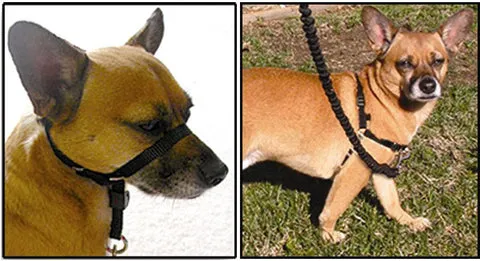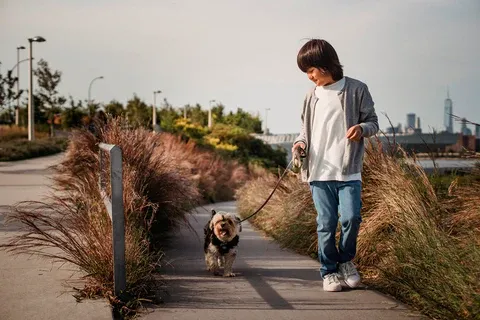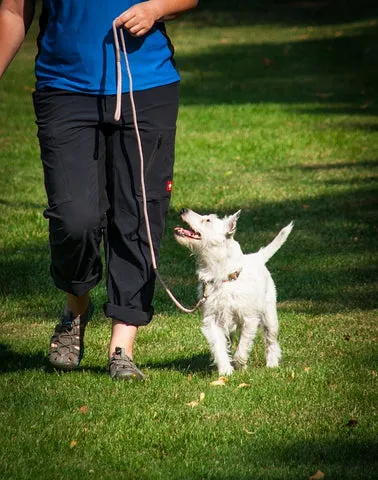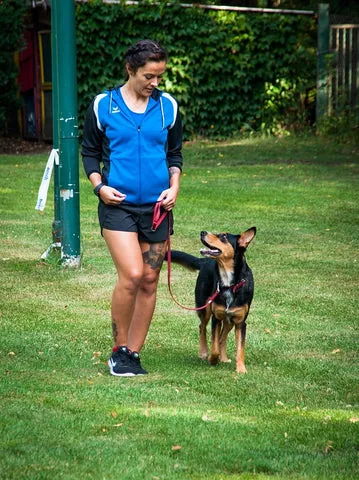Leash training a puppy is essential for enjoyable walks where your dog stays by your side without pulling, stops when you do, and ignores distractions like other dogs or people. Whether you’re dealing with a energetic puppy or an adult dog that pulls on the leash, these proven steps will help you achieve polite loose-leash walking. Many owners struggle with this, but with patience and positive reinforcement, your pup can learn to heel happily. For more tips on teaching a dog to walk on a leash without pulling, check our detailed guide.
 Small dog on a leash in a grassy area
Small dog on a leash in a grassy area
Before starting leash training a puppy, consider tools like a front-attachment harness or head collar to gently discourage pulling. These are safe for all sizes and provide better control, especially for strong pullers or small owners with large breeds. Always pair them with a standard 6-foot leash—avoid retractables, as they can cause injury if your dog hits the end at full speed.
 A small tan dog wears a head collar on the left and a front-attachment harness on the right
A small tan dog wears a head collar on the left and a front-attachment harness on the right
Prior Steps for Successful Leash Training
The foundation of leash training a puppy begins at home or in a low-distraction yard. Use high-value treats like pea-sized cheese or meat, and a treat pouch for easy access. If food isn’t motivating, opt for a tug toy or ball toss. The goal is associating walking nicely by your side (left or right—left is traditional) with rewards right at your thigh.
 Young boy walking a small dog on a leash
Young boy walking a small dog on a leash
Step-by-Step Leash Training Guide
Step 1: Make Walking with You Rewarding
Attach a 10-20 foot long line (not retractable) to a standard harness in your yard. Walk briskly and randomly. When your puppy walks beside you, praise and treat by your thigh. Reward every step initially, then fade treats as they improve. If they’re distracted, try when hungrier.
Step 2: Teach Attention with “Let’s Go”
When your puppy lags or wanders, say “let’s go” cheerfully, slap your thigh, and walk away. Reward generously when they catch up by your side. If the leash tightens, apply gentle pressure as a cue—not to yank—then release and treat upon response. Practice until they return quickly.
Explore variations like how to teach dog to walk on leash without pulling for breed-specific advice.
Step 3: Control Sniffing and Potty Time
Puppies need sniff breaks, but on your terms. Every 5 minutes, say “go sniff” as a reward instead of a treat. If they pull, end it with “let’s go” and walk away. This builds impulse control during leash training.
Step 4: Handle Speed Changes and Distractions
Shorten to a 6-foot leash. Vary pace, stop suddenly, or change directions—reward sticking by your side. Use extra treats for challenges. For related issues like teach a dog to walk on a leash without pulling, see our step-by-step resources.
 White dog on leash watching owner
White dog on leash watching owner
Transitioning to Street Walks
Apply yard techniques outdoors with added distractions. Use “let’s go” for pulls, turn opposites, and extra rewards near squirrels or dogs. A no-pull harness helps. Allow scheduled sniff breaks to keep them engaged.
 Woman walking attentive black and tan dog
Woman walking attentive black and tan dog
If hyperactivity persists, learn how to get dog to stop jumping on couch for better overall manners.
Advanced Challenges in Leash Training
Toss a treat or ball 20 feet ahead on a 6-foot leash. If they pull, “let’s go” and turn. Reward calm approaches. Start easy with longer lines.
 Small white and brown dog on a leash in the snow
Small white and brown dog on a leash in the snow
Common Troubleshooting Tips
- Crossing in front: Shuffle feet to block.
- Lagging: Encourage if scared; gentle pressure for sniffing.
- Inconsistent pulling: Reward longer stretches by your side, ignore short returns.
Training to Heel for Precision
For tight control past distractions, lure with a treat in your closed fist at thigh level, say “heel,” and reward nose-following. Fade the treat, using fist as cue. Practice indoors first, then outdoors.
Leash training a puppy transforms chaotic walks into bonding time. Consistency yields results in weeks—celebrate progress! Ready for more? Explore how to train your dog to live outside or contact Dog Care Story experts for personalized puppy training advice.
